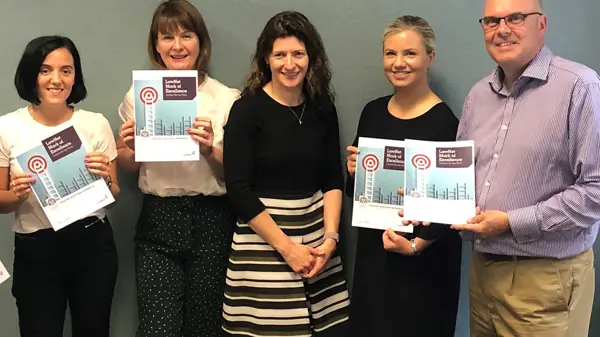The human touch: strengthening client relationships in a digital world
I explored this question in my recent chapter for What Clients Want from Law Firms, a new title from Globe Law and Business. My focus? How law firms can get upfront and personal in their relationships.
Client experience (CX) is something I’ve championed for more than a decade at LawNet, embedding it into our bespoke ISO quality standard for member firms. It’s a core priority for our network - and a topic I’m deeply passionate about.
CX covers a vast range of issues, but in this chapter, I zeroed in on one fundamental truth: despite all the automation, digital transformation, and efficiency gains reshaping the sector, clients still want to be treated as people first—not just as legal problems to be solved.
Clients today are measuring their legal experiences not just against other law firms, but against top tier client centric brands. If you're in the UK, that might mean brands like John Lewis, Nationwide, or even Timpson, who regularly come top of the Institute of Customer Service's performance benchmarking. And they expect not only professional advice, but empathy, transparency, and a real sense that their lawyer gets them.
We've been canvassing the clients of our law firm members for over a decade now and those are the themes that consistently come out of our research. And that happens through what we call our Excellence Mark program which helps our firms put client experience front and centre by measuring what matters, learning from real feedback and making continuous improvements.
And that focus becomes more important as each year goes by, because clients have increasing expectations, they have more choice in how they access legal services and very public ways to share their experiences, good or bad. It means that getting client experience right isn't just good practice; it's a key part of staying competitive. Harnessing the power of personalised client care helps firms build lasting trust, enhance client satisfaction and differentiate in a competitive marketplace.
There are five key things that I would highlight from my chapter.
Firstly, and this might be a little bit counterintuitive, but building personalised client relationships actually doesn't start with the client at all. It starts with your culture. Because when your staff feels supported, empowered and safe, they're more likely to build trust with clients. Empathy and great service can't just be bolted on after you've done everything else. They're at the core of your business and they need to be role modelled and rewarded and reinforced across the firm.
Essentially this is a leadership issue. We know from our years of research that how your people feel at work directly affects how they treat your clients. Getting your culture right and becoming a place where people want to be isn't just an HR goal, it impacts your clients too. So it's something you need to be taking really seriously.
Secondly, it's the idea that becoming truly client centric actually isn't easy at all: at LawNet, we describe it as a journey. You start off with client service, where you're focused on meeting the immediate needs of your client. Then you might move on to thinking more broadly about client experience, focusing on different interactions with your team and what it feels like to be a client of your business. Then, when you get to the end of that journey, you reach client centricity, which demands a more fundamental shift in your business.
It is about rethinking how the firm operates at every level and ensuring that the client's interests are the driving force behind all decisions and actions that get taken. One of the practical ideas that I know some of our LawNet member firms are using to help make this happen is to have a symbolic empty chair in key meetings, to represents the client. They might even put a name or put a badge in front of them on the table that says ‘the client’. It's an apparently small thing, but when you've got a table full of people all thinking about one particular issue, it provides a powerful reminder to keep the client front of mind. When it’s the impact on the client that we really need to be thinking about, this simple device can help make that happen.
Then thirdly, the other thing I focus on in the chapter is the power of empathy and emotional intelligence. Clients won't remember every detail of the legal process, but they will remember how you made them feel. So that's what's really important. And actually, empathy can be a point of competitive advantage. It reduces anxiety, especially in stressful matters, which legal matters often are, and builds loyalty. Studies have shown that clients are more likely to recommend a lawyer who shows emotional intelligence over one who just demonstrates legal brilliance.
And lawyers who understand a client's personal or commercial context, not just the specific problem that they're having in that moment in time can go on to become trusted advisors, not just service providers, which is where relationships grow.
Fourthly, never underestimated the value of investing in soft skills. You can be the best lawyer in the world, but your legal brilliance can easily lose its shine where there is poor communication, so a client may come away feeling like they've had a bad experience.
Sensitive follow ups, thinking about clarity and tone: these are the types of things that shape client perceptions. It's really important to provide personal development for your people in these areas as well. Amongst our members we've seen some really powerful results when firms invest in their people’s skills, especially around communication and relationship building.
Some firms are recording client calls and using them as part of the training process with their fee earners, others are building crib sheets and structured learning programmes, but this is where your culture is critical. Everybody has to feel that they're in a safe place for that to happen and confident that they're supported, not monitored or criticised, and part of a team where everyone has made a collective commitment to continuous improvement in how client experience works.
We know that sort of learning journey, where everyone's involved, really works. We see this with our member firms, who are audited on their client delivery as part of our mandatory ISO LawNet quality standard. Our Excellence Mark programme supports firms to measure, monitor and improve client experience, with assessments including both in-depth prospective client evaluations - using anonymous walk-ins, telephone and online visits - and digital satisfaction surveys.
Over the past eleven years this has become the largest client experience research initiative within the legal sector, with some 80,000 client satisfaction surveys and almost 6,000 client experience reviews, where independent researchers pose as potential clients. From the early days of walk-in and telephone reviews, firms are now tested on everything from live chat to their appearances at business events.
But this isn’t just about gathering data. The insights from client feedback are actively used to shape improvement initiatives, inform training, and support the ongoing development of teams across our member firms. And it’s working — over the past decade, average client experience scores across the network have risen from 52% to 76%, with our top-performing firms reaching the high eighties. That puts them on a par with some of the UK’s most trusted brands, like John Lewis, Nationwide, and Timpson. Achieving that kind of progress takes more than just new tech - it comes from a deep commitment to client centricity and investing in the skills of your people.
Which brings me to the final point in my chapter: technology should enable, not replace the human element. So yes, clients are increasingly expecting digital convenience. They want faster onboarding. They want real-time updates. They want self-service tools. But your use of technology needs to enhance, not erode, the personal connection that you're building with them. There's a risk of over-automating and losing that critical human touch, and the firms that will thrive are those that use technology to create space for more meaningful interaction with clients, not instead of it.
Because personalisation doesn't stop after that first contact, when you check how people want to be communicated with or understanding their needs, it’s what continues to happen afterwards. So it's the thoughtful follow-up, the check-in, the sense that the firm really cares, that's what builds lasting loyalty.
Essentially, at its heart, personalised client care is about mindset. It's about putting the client at the centre of everything, not just at the surface level of service delivery, but deep into the culture, values and operations of your firm, because that's how personalised relationships will have the focus and support they need to flourish.
Join in with the conversation about this article on LinkedIn here.
Read the full chapter on the LawNet website, CLICK HERE
Watch the full webinar, with other contributors to the book, CLICK HERE









